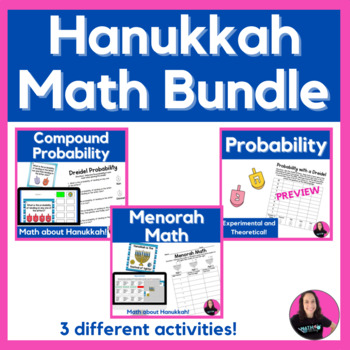Hanukkah Math Bundle for Middle School Math / Chanukah Activities
- Zip
- Google Apps™

Products in this Bundle (3)
Description
This bundle includes 2 probability activities for middle school math and Menorah Math, which will have students add up the number of candles needed on Chanukah to determine how many candles are needed in total. Menorah facts are included to teach about the holiday.
Students will practice determining the compound probability involved in spinning a dreidel and find the experimental and theoretical probability of spinning dreidels.
Don't have any dreidels? Just search online and spin digitally!
Your Jewish students will love to feel represented! No Jewish students? Then your students will learn about a different holiday!
Printable versions and answer keys included! No preparation needed!
This resource includes:
- What is a Dreidel? (Experimental and Theoretical Probability with Dreidels)
- How to play the Dreidel game
- Collect the experimental probability data
- Answer questions about experimental and theoretical probabilities
- Self Checking Google Sheet with 6 problems (Compound Probability with Dreidels)
- Printable version - 3 pages (Compound Probability with Dreidels)
- Self Checking Google Sheet with 16 problems (Menorah Math)
- Printable version (Menorah Math)
- Answer keys
Don't forget to leave feedback on your paid items so that you can earn FREE TpT credits towards future items! Your feedback is greatly appreciated!





